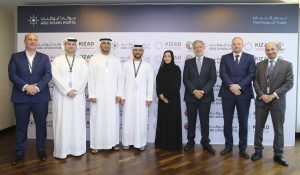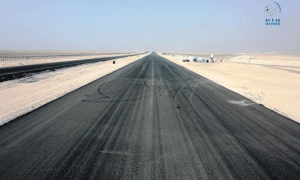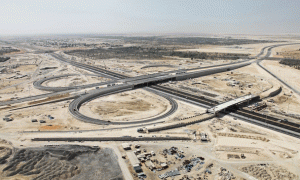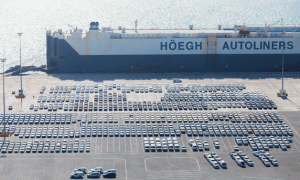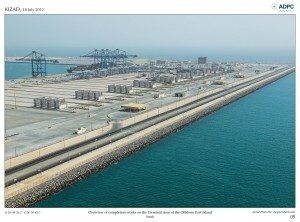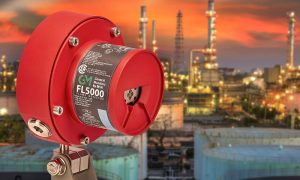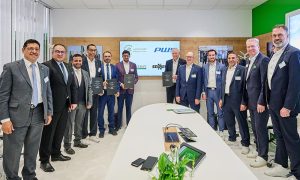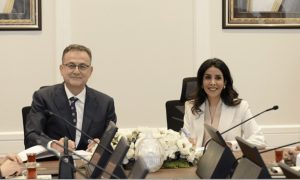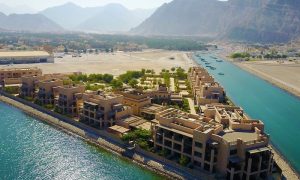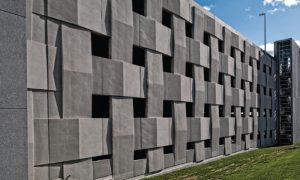Tony Douglas onsite at Khalifa Port
in Abu Dhabi

If you can’t find Tony Douglas, the new CEO of Abu Dhabi Ports Company (ADPC), perhaps you’re looking in the wrong places.
Have you checked under the sea, where he was last month, personally inspecting the condition of coral surrounding the US $240 million environmental breakwater the company has implemented to conserve the Gulf’s largest coral reef, just a few metres offshore from its Khalifa Port project?
Not one to rule from his desk, colleagues describe Douglas — who joined ADPC in June — as a “hands-on” CEO, and likewise, he calls himself a “go, look, see” type of leader. It’s his natural curiosity and hunger for a challenge that led him to Abu Dhabi to spearhead the development of the 420km² Khalifa Port and Industrial Zone (KPIZ), a project four times the size of Abu Dhabi island and two-thirds the size of Singapore.
It may be the largest, but KPIZ is by no means the first big project Douglas has undertaken; he initially made a name for himself as managing director and later CEO of the UK’s busiest international airport, London Heathrow, where he managed the delivery of the new Terminal 5 mega-project, bang on time and on budget.
In June 2007, he joined the UK’s largest privately-owned construction firm Laing O’Rourke as chief operations officer for Europe, the Middle East and Asia, running the London Olympics 2012 programme management. This post also brought him to the emirates, where he was involved in high-profile developments such as Dubai’s Atlantis hotel and headed up the Aldar-Laing O’Rourke joint venture developing the Al Raha Beach project in Abu Dhabi.
However, media reports in UK newspaper The Times, in November 2009, suggested Douglas had become frustrated at not being given more responsibility at the company, which he reportedly joined with a view to becoming chief executive, succeeding the current chairman and chief executive Ray O’Rourke.
With a number of job opportunities believed to be on the table, Douglas resigned from Laing O’Rourke that month.
But it seems his recent appointment at ADPC, an Abu Dhabi Government body set up by Emiri decree in 2006, is enough to quench Douglas’ thirst for responsibility – for the time being. Crucial to achieving the vision set outby the Abu Dhabi 2030 Urban Structure Framework Plan (Abu Dhabi 2030), Abu Dhabi Ports Company is expected to play a key role in diversifying the emirate’s economy by contributing significantly to GDP by 2030.
Not only does the company manage and operate Abu Dhabi’s existing nonmilitary, non-oil and gas ports, it is responsible for delivering Abu Dhabi’s largest infrastructure project, KPIZ. Situated at Taweelah, halfway between Dubai and Abu Dhabi, the KPIZ project is expected to become one of the world’s biggest industrial zones, with its own dedicated port.
There are three key elements to the KPIZ project: Khalifa Port and Industrial Zone A, which are both currently under construction and are expected to open in quarter four of 2012, and lastly Industrial Zone B, on which construction has not yet commenced.
The Khalifa Port occupies an area of 3.4km², including onshore and offshore segments. Stage one A of the project, which comprises the offshore quay rea, is 2.7km² or the size of nearly 400 football pitches.
Industrial Zone A covers 51km² and is home to the only current anchor tenant Emirates Aluminium (EMAL). Other
industries being targeted according to sector include: petrochemicals, steel, pharmaceuticals, life sciences, chemicals, biotechnology, food and beverage, metals and logistics. ADPC expects the zone to be fully occupied by 2018.
Spanning a huge area of 365km², Industrial Zone B makes up stage three of the project, comprising, among others, housing, high-technology, lightmanufacturing and logistics industries.
Infrastructure works are scheduled to start in 2013. You don’t have to be a mathematician to work out that the industrial zone is enormous; accounting for as much as 99% of the Khalifa Port and Industrial Zone development.
“This is an industrial zone that has a port, not to be confused with a port that has an industrial zone. While the port is a massively-important part of the development, people need see it in context,” asserts Douglas.
It is in this sense that he says the name Abu Dhabi ‘Ports’ Company is “slightly misleading”.
ADPC is in the process of giving birth to a giant and genetically-modified offspring. The industrial zone will quickly become infinitely larger than its parent company.
Having launched in 2008, KPIZ is in its ‘terrible twos phase’, yet — and quite surprisingly considering the onset of the global economic downturn — Douglas claims that progress has been relatively steady sailing.
“KPIZ has been protected from the slowdown because by the time the first phase is opened in 2012, we hope that the economic challenges observed in recent years will be behind us. If you don’t take a long-term view on projects of this magnitude, you’ll never do them.”
High expectations
But ADPC has a lot to live up to over the next two decades to fulfil the objectives outlined in the Abu Dhabi 2030 plan, with many of its ambitions for economic diversity to be realised through KPIZ.
“For KPIZ to operate as intended, it has to be linked to world-class infrastructure,” says Douglas, adding that the area is signalled to become a major transport hub connected to Emirates Road, with air links including Abu Dhabi International Airport (30km away), Dubai Central Al Maktoum Airport (50km away), Dubai International Airport (85km away) and Al Ain International Airport (170km away), and planned rail connections to be developed through Etihad Rail, formerly known as Union Rail.
Douglas reveals that ADPC is “very much involved” with Union Rail, and a master-plan linking KPIZ to its network has already been agreed. Furthermore, Douglas says once operational, Khalifa Port will replace the existing Mina Zayed Port as the “gateway to Abu Dhabi”.
Khalifa Port traffic is estimated to reach two million containers and nine million tonnes of cargo a year from 2012, which is four times the number of containers handled by Mina Zayed Port in 2010. By 2030, this number is forecast to grow to 15 million containers and 35 million tonnes of cargo annually.
In addition, EMAL, which is due to receive its first cargo shipload at Khalifa Port this month, will handle an estimated four million tonnes of cargo per year from quarter four of 2010. The company is already running the world’s largest, single-site aluminium smelter, which opened in December.
Considering the forecast traffic loads and – perhaps even more significantly – the fact that the land Mina Zayed Port occupies has become one of the most valuable patches of real estate in the emirate due to its proximity to Saadiyat Island, Reem Island and downtown Abu Dhabi, it’s not all that surprising that Mina Zayed Port will cease to exist after 2012.
As for plans to redevelop the land – watch this space. By 2030, it is expected that KPIZ will have created around 150,000 jobs and be home to 100,000 residents. These numbers create an idea of how the development will work towards targets set out in Abu Dhabi 2030.
However, while the plan is laid out in far greater detail than you might see in other countries, it is not a detailed route map — and was never intended to be, according to Douglas.
“But on a personal level I find it extremely helpful for illustrating how the many complex developments fit together. It’s a template. Without longterm vision you can’t sensibly develop a project the size of a small country.”
Bite-size pieces
The magnitude of this project is staggering, but Douglas remains unfazed: “As with any challenge, you start by breaking it down into bite-size pieces. In construction you have phased deliverables; driven timelines and budgets,” he asserts.
To date, construction works have largely focused on the port, in line with the phase one deliverables. Masterplanning of the port was initiated in 2006 and completed by Halcrow, and Moffatt & Nichol Engineering. Detailed design development was performed by Scott Wilson Kirkpatrick and Moffatt & Nichol Engineering.
The first port const ruction contract to design and construct was awarded in 2007 to the Khalifa Port Marine Consortium (KPMC) comprising Archirodon Construction (Overseas), Boskalis Westminster Middle East and Hyundai Engineering and Construction Company. Works included reclamation of the port island, the berthing basin and entrance channel, all associated edge treatment, revetment and breakwaters, and were completed last month.
ruction contract to design and construct was awarded in 2007 to the Khalifa Port Marine Consortium (KPMC) comprising Archirodon Construction (Overseas), Boskalis Westminster Middle East and Hyundai Engineering and Construction Company. Works included reclamation of the port island, the berthing basin and entrance channel, all associated edge treatment, revetment and breakwaters, and were completed last month.
Following this, the second port construction contract was awarded in September 2009 to Archirodon for the detailed design and construction of the EMAL seawater cooling system and pipelines. This was completed in the second quarter of this year.
Currently, there are six remaining port contracts active, including: port special systems works by Al Jaber-GIS; MV power – onshore and offshore works by Larson & Toubro, onshore civil works and buildings by Al Habtoor Leighton Group, which is also completing the offshore terminal pile installation; and offshore civil works and buildings are being carried out by a joint venture between Ed Zublin AG and Al Jaber.
Last month, Hyundai Engineering and Construction was awarded a $329 million contract for project management, design, procurement, construction, testing and commissioning of all civil works associated with the construction of the offshore terminal area.
Work began immediately and is scheduled for completion in quarter four of 2012. The contract was the fourth major package awarded within just over a year for KPIZ.
Douglas confirms that the cost of KPIZ, taking into account phase one Industrial Zone A works and the opening of the port will accumulate to AED 26.5 billion ($7.2 billion) by the last quarter of 2012. Industrial Zone A accounts for AED 13.5 billion ($3.6) of this figure, works completed to date include the design of primary infrastructure, including roads and utilities, by Mouchel Middle East.
Mass filling of low-lying areas to a set minimum level has also been finished by Al Jaber and Ghantoot.
There are still a number of works to be completed as part of phase one, including the construction of the zone’s primary transportation network and side-wide utilities.
There is a range of phase one secondary infrastructure packages, smaller in value but none-the-less important, which will be awarded from Q4 of this year through to Q1 of 2011.
“Overall phase one is well on track,” he concludes, which brings us onto the logistics of transferring operations from Mina Zayed Port to Khalifa Port.
“It’s not as complex as you might think, transferring an airport would be a lot more complex,” a confident Douglas says. ADPC has put the systems and people in place, and has developed a “disciplined and structured migration plan”, he adds.
Port pipeline
Looking forward, Douglas cannot reveal a phase two completion date or put a value on it, except to say that the cost is “big”, reflecting the task at hand.
When asked about other projects in the pipeline, he says there are a few small port developments coming up, adding: “KPIZ is one of the world’s biggest port and industrial zone developments, that’s enough to keep us busy for now — to be honest.”
It looks like Douglas has finally met his match in the world of big projects, and he appears to be enjoying every
minute of it. “It’s an exciting project that is of national importance. We recently presented to HH Sheikh Mohammed, which was a great privilege. Everyone’s confidence is behind the development of KPIZ and it is mega-projects like these that make me tick,” says Douglas.
By Louise Birchall

